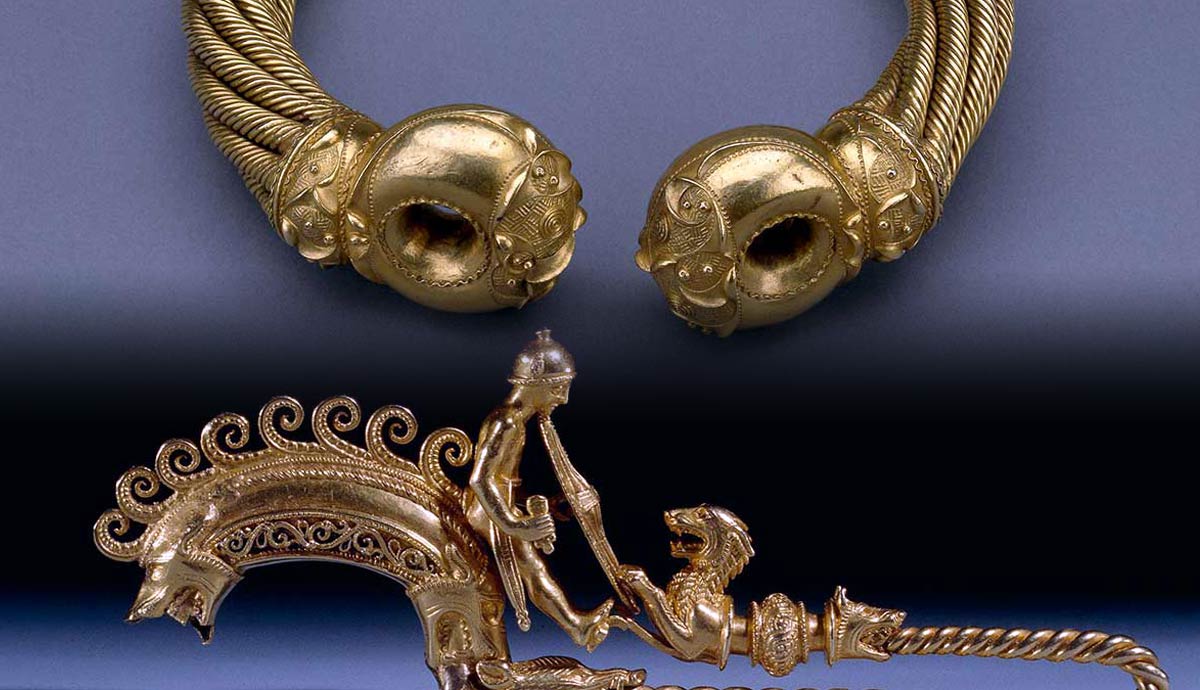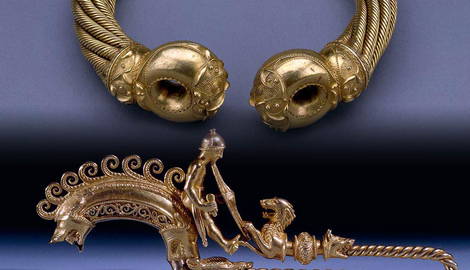
Ancient Greek and Roman writers characterized the Celts as being particularly interested in adorning themselves with gold Celtic jewelry. Strabo wrote:
“To the frankness and high spiritedness of their temperament must be added the traits of childish boastfulness and love of decoration. They wear ornaments of gold, torques on their necks, and bracelets on their arms and wrists, while people of high rank wear dyed garments besprinkled with gold. It is this vanity which makes them unbearable in victory.”
But was this just a generalization by an author intent on portraying the Celts as barbaric and outlandish, the opposite of their more civilized Greek and Roman neighbors? To some extent, archaeological evidence from Iron Age Celtic graves has shown that they did indeed wear jewelry. The question of how much was dependent on both gender and social class.
Jewelry and Adornment as Status Symbols

Celtic society was hierarchical, consisting of an unfree class, a free class of working people, a higher class of individuals like craftsmen, druids, bards, and prophets, and the warrior class, and the elite. Only the elite—and, in later centuries, the warrior class—would have had access to the wealth necessary to own large quantities of jewelry. When it comes to analyzing archaeological finds of Celtic jewelry, it is worth considering that what jewelry and adornment reveal is primarily centered on the experience of the elite.
Based on evidence from ancient textual sources, like the quote from Greek geographer and historian Strabo above, Celtic peoples are historically characterized as having been prone to adorning themselves with jewelry. Archaeological evidence suggests that men’s dress was relatively unadorned compared to Celtic women, but nevertheless, both men and women wore more jewelry and adornments than their Greek and Roman neighbors. The best-known piece of jewelry associated with the Celts—and the one utilized most frequently as a symbol of status and wealth—is the torc, a large gold or bronze neck-ring.
Torcs appear (based on evidence from burials) to have been worn primarily by members of the elite class during the Hallstatt Period (c. 1200 BCE-450 BCE), with their use becoming more widespread and expanding to the warrior class during the La Tène Period (450 BCE-43 CE).
The appearance of a torc in depictions of Celtic peoples aids in dating those depictions to the La Tène Period. In that period most neck-rings found in female graves were bronze and most found in male graves were gold, which presents some evidence of a gendered distinction.

Some torcs appear to have been found in votive contexts: for example, the Snettisham hoard and the Broighter torque from Co. Derry, Ireland. The Snettisham area has produced many gold neck rings that suggest ritual significance. While torcs being utilized in a votive context would not have been worn, and therefore cannot tell us about torcs as status symbols in everyday society, that they were clearly used as ritual objects indicates that they were incredibly valuable objects for Celtic peoples, so much so that they gained a spiritual significance.
Textual Evidence of Celtic Adornment

In addition to the earlier quote from Strabo describing Celts as vain in their love of personal decoration, there are a number of other mentions of Celtic people wearing jewelry in Classical texts.
Cassius Dio described Boudica, the famous warrior queen of the Brythonic Celtic Iceni tribe as follows:
“In stature she was very tall, in appearance most terrifying, in the glance of her eye most fierce, and her voice was harsh; a great mass of the tawniest hair fell to her hips; around her neck was a large golden necklace; and she wore a tunic of diverse colors over which a thick mantle was fastened with a brooch. This was her invariable attire.”
Whether or not this is accurate, the use of pins and brooches to fasten garments is attested by finds from archaeological sites, particularly burials. That she is also recorded as wearing a torc speaks not just to her importance as a leader, but to the repeated significance of torcs among the elite and warrior classes.

Livy also wrote of a Roman general who adopted the name Torquatus after he defeated a group of Gauls and stole their torcs as a victory spoil:
“To the body of his fallen foe, he offered no other indignity than to despoil it of one thing — a chain which, spattered with blood, he cast round his own neck. The Gauls were transfixed with fear and wonder, while the Romans, quitting their station, ran eagerly to meet their champion and brought him with praise and gratulation to the dictator. Amidst the rude banter thrown out by the soldiers in a kind of verse, was heard the appellation of Torquatus and thereafter this was given currency as an honored surname.”
Again, this analysis and characterization of Celtic peoples—in this case, Gauls—centers on the torc as an object of great significance to the Celts. Whether this serves as a further characterization of Celtic peoples as vain or not, jewelry was evidently an important component of Celtic self-fashioning and honor.
Depictions of Jewelry in Celtic Art

Depictions of Celtic people are rare. Most images of the Celts are male, and many are Roman or provincial Roman in nature, meaning that images created from the Celtic perspective are even more rare. We are left with even fewer depictions of Celtic women. Therefore, we are unfortunately unable to glean much about Celtic personal adornment from the few images of the Celts that we have from the Iron Age, although these images provide modern historians with an idea of Celtic clothing and hairstyles.
On the rare occasions in which Celts are shown adorned in art, it is usually only with a torc, despite ancient textual sources making frequent references to the Celtic proclivity for adorning themselves with gold. We also know from excavations of Celtic graves that these textual references were not far off.
Perhaps the appearance of personal adornment in images of the Celts being limited to the torc is yet another example of the neck-ring’s significance. One of the most famous anthropomorphic images of a Celtic individual is that of the Mšecké Žehrovice head. The head was found in a settlement of the same name in modern-day Czechia. A life-sized sculpture of a head, the figure is shown with facial features and curved brows, complemented by a curved mustache. A sizeable torc forms the base of the statue.
The torc is a major clue about the potential status of the person depicted: while the identity of the figure has never been determined, the inclusion of the torc and the fact that the statue was found in a votive context in a settlement suggests that he was an individual of high social status and of great importance to his community: either a warrior or a druid.
Where Has Celtic Jewelry Been Found?

Celtic jewelry from the Hallstatt Period has predominantly been found in graves, and jewelry from the La Tène Period is more commonly found in settlements. It should be noted that because La Tène items are more often found separate from the individuals that would have owned them, Hallstatt Period objects are typically more useful in identifying gendered trends in personal adornment.
Fibulae, or pin brooches, are the most commonly found items of personal adornment both in graves and in settlements. This makes sense, as they were the most widely used personal ornaments during the Iron Age. From a practical perspective, fibulae could also be worn by individuals outside of the elite classes as a means of fastening clothing. Their constructional changes and technological refinements have made them useful regional and chronological indicators.
Gender and Celtic Adornment

As mentioned, both Celtic men and women wore jewelry. It is important to note that, under previous archaeological standards, graves were often sexed based on the nature of ornaments found with the skeletons contained within. When better standards of skeletal analysis were developed, it was found that burials previously thought to be female belonged to men.
It can therefore be assumed that Celtic peoples, by and large, may have had more fluid gender conventions when it came to adornment compared to their Greek and Roman neighbors, or that gold jewelry was in part associated with wealth and masculinity.
Some items of personal adornment, as well as the quantity of objects, can help indicate if a grave belonged to a woman. Characteristic items in female graves include hairpins, found singly or in large numbers around the head, tubular or solid cast bronze torcs and beaded necklaces, arm rings, bracelets, and armlets found in pairs (the armlets are barrel-shaped covering the entire forearm).
It is suggested that men never wore arm rings in pairs. Leg rings have been found in female graves and appear to have been an entirely female ornament. Earrings are found in male and female graves, though more frequently and occasionally in greater numbers in the latter.
Pendants are found in both male and female graves, but they appear to be most frequently associated with children. Girls of the Hallstatt and early La Tène culture wore amber chains and amulets.

It is also worth acknowledging tattooing as a form of bodily adornment as well. Given Celtic preferences for rich textiles and an abundance of metalwork jewelry, it is not unlikely that they would have also painted or tattooed their bodies. There is no major suggestion of this being a gendered activity, and there are some references to painted skin and the use of woad, a form of blue dye that could be extracted from leaves.
Bibliography
Maier, B. (2018). The Celts: A History from Earliest Times to the Present. Edinburgh University Press.
Champion, S. (1996). Jewellry and adornment. In M. Green (Ed.), The Celtic World (pp. 411-419). Routledge.
Lloyd-Morgan, G. (1996). Appearance, life and leisure. In M. Green (Ed.), The Celtic World (pp. 95-120). Routledge.










